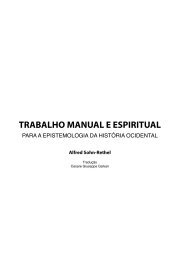Perversion the Social Relation
Perversion the Social Relation
Perversion the Social Relation
- No tags were found...
You also want an ePaper? Increase the reach of your titles
YUMPU automatically turns print PDFs into web optimized ePapers that Google loves.
34 Dennis Fosteras defenses against human mortality. The "human covenant" (180) thatkeeps humans bound to <strong>the</strong> fixed image is a version of <strong>the</strong> oedipal contractthat we make with <strong>the</strong> One God: limit your desire, and you will beimmortal.The fixed image, of course, is incompatible with <strong>the</strong> reality of reproduction.After all, in reproduction <strong>the</strong> image is subject to chaotic fluctuationas genes err, language slips, and time and accident happen. The"biologic revolution" Burroughs imagines would cause "unimaginablechaos, horror, joy and terror, unknown fears and ecstasies, wild vertigosof extreme experience, immeasurable gain and loss, hideous deadends" (in). Sounding like Nietzsche here, Burroughs mixes perspectives,giving us both <strong>the</strong> danger such a step would pose to <strong>the</strong> rationalworld as well as <strong>the</strong> ecstasy it could bring. But <strong>the</strong> chaos he describesis no longer just a paradoxical problem leading to a cultural impasse;ra<strong>the</strong>r, it has emerged as a solution within contemporary chaos <strong>the</strong>ory.The apparently romantic step that Burroughs proposes—"from wordinto silence. From Time into Space" (115)—gestures toward <strong>the</strong> sublime("awakened pilgrims catch hungry flashes of vast areas beyond Death tobe created and discovered and charted"). But it also suggests that onemight let go of <strong>the</strong> commitment <strong>the</strong> West holds to linear trajectories ofmeaning and motion that culminate in <strong>the</strong> presence of Voice and Truth.Burroughs writes, "Imagine you are dead and see your whole life spreadout in a spatial panorama, a vast maze of rooms, streets, landscapes, notsequential but arranged in shifting associational patterns" (138). That is,to imagine your "self" dead means to imagine that <strong>the</strong> parts of your lifeare not fixed by sequence, but by shifting patterns of connection: "Thishappens in dreams of course." Dreams tell us something about a conditionof our lives that we call being dead or, ra<strong>the</strong>r, beyond dead. Bycomparison with <strong>the</strong> linear path of life, this image of death is vividlydynamic. Chaos does not refute <strong>the</strong> necessity of temporality—dynamicchange, whe<strong>the</strong>r in physical systems or in dreams, is irreversible—but<strong>the</strong> fixed intention, <strong>the</strong> target of time's arrow, vanishes. In "chaos," oneloses <strong>the</strong> delusion of individual purpose, direction, control, which waswhy <strong>the</strong> One God put an end to it. The image that chaos and <strong>the</strong> <strong>the</strong>oryof complexity substitute for control is <strong>the</strong> dynamic order of <strong>the</strong> developingimage, of <strong>the</strong> fractal patterns generated by non-linear equations,where scale replaces time as complex development replaces purposefulgrowth.








